Introduction
- Books Name
- CBSE Class 6 Science Book
- Publication
- Param Publication
- Course
- CBSE Class 6
- Subject
- Science
Introduction
We saw that our food and clothes have so much variety in them. Not just food and clothes, there is such a vast variety of objects everywhere. We see around us, a chair, a bullock cart, a cycle, cooking utensils, books, clothes, toys, water, stones and many other objects. All these objects have different shapes, colours and uses.
All objects around us are made of one or more materials. These materials may be glass, metal, plastics, wood, cotton, paper, mud or soil.
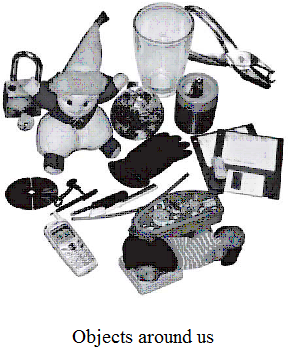
Activity–1
AIM : To find out some common materials around us and their objects
Different types of objects that are made from the same material
Material Objects made of these materials
Wood Chair, table, plough, bullock cart and its wheels, ...
Paper Books, notebooks, newspaper, toys, calendars,...
Leather
Plastics
Cotton
Above table lists some common materials. We can also add more materials in Column 1 that are known. Now, try and think of everyday objects, that are made mainly of these materials, and list them in
Column 2.
First, we grouped objects in many different ways. We then found that objects around us are made of different materials. At times, an object is made of a single material. An object could also be made of many materials. And then again, one material could be used for making many different objects.
Objects around us
- Books Name
- CBSE Class 6 Science Book
- Publication
- Param Publication
- Course
- CBSE Class 6
- Subject
- Science
Properties of Materials
We generally use a tumbler to keep a liquid. A tumbler cannot be made from cloth. We need a tumbler made from glass, plastics, metal or other such material that will hold water. Similarly, it would not be wise to use paper-like materials for cooking vessels.
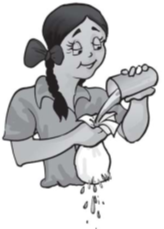
Using a cloth tumbler
we choose a material to make an object depending on its properties, and the purpose for which the object is to be used.
Some properties are discussed here.
(i) Appearance :
Materials usually look different from each other. Wood looks very different from iron. Iron appears different from copper or aluminium. At the same time, there may be some similarities between iron, copper and aluminium that are not there in wood.
Activity–2
AIM : To show that certain materials have lustre.
Material required : (i) Small pieces of paper (ii) cardboard (iii) a thin piece of wood (iv) a small strip of plastic (v) thin wires of copper, aluminium and iron (vi) heavy scissors or a metal cutter
(vii) sand paper.
Method :
(a) Cut each of the materials with heavy scissors or metal cutter. Carefully observe the cut surface of each material.
We will notice that in case of paper card board, wood plastic, etc., the cut surface is not shining.
However, in case of thin wires of copper, aluminium and iron, the cut surface is shining.
(b) Rub each of the material with sand paper. Carefully observe the sand papered surface of the material.
We will notice that in case of paper cardboard, plastic and wool, the sand papered surface is not shining.
However, in case of thin wires of copper, aluminium and iron, the sand papered surface is shining.
So it is cleared that certain materials like metals have lustre.
(ii) Hardness :
When we press different materials with our hands, some of them may be hard to compress while others can be easily compressed.
Materials which can be compressed or stretched easily are called soft while some other materials which are difficult to compress are called hard. For example, cotton or sponge is soft while iron is hard.
(iii) Solubility :
Some substances like sugar, salt etc. completely disappear or dissolve in water. These substances are soluble in water. Other substances like sand, chalk powder etc. do not mix with water and do not disappear even after we stir for long time. These substances are insoluble in water.
Water plays an important role in the functioning of our body because it can dissolve a large number of substances.
Properties of materials
- Books Name
- CBSE Class 6 Science Book
- Publication
- Param Publication
- Course
- CBSE Class 6
- Subject
- Science
Activity–3
AIM : To prove that some solids are soluble in water.
Material required : (i) A rack of test tubes (ii)water (iii)common salt (iv)sugar (v)washing soda (vi)chalk powder and sand.
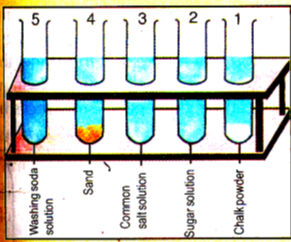
Method : Add a pinch of chalk powder in the first test tube, a pinch of sugar in second test tube, a pinch of common salt in the third test tube, a pinch of sand in the fourth test tube and a pinch of washing soda in the fifth test tube. Pour water into each test tube such that half of each test tube is filled with water. Shake each test tube vigorously and replace in the rack. You will notice that sugar, common salt and washing soda disappear in water, and hence are soluble substances. Sand and chalk powder do not dissolve in water, and hence are insoluble substances.
Some liquids like vinegar, lemon juice etc. completely mix with water. These liquids are said to be miscible in water. Some others like oil do not mix with water and form a separate layer when kept aside for some time. These liquid are immiscible in water. Some gases are soluble in water whereas others are not. Water, usually, has small quantities of some gases dissolved in it. For example, oxygen gas dissolved in water is very important for the survival of animals and plants that live in water.
(iv) Objects may float or sink in water :
Insoluble solids separate out from water. Some of these materials that do not mix with water, float to the surface of water. Others may sink to the bottom of the tumbler.
Some substances like oil, wood etc. float on water while substances like stone, metal piece etc sink in it.
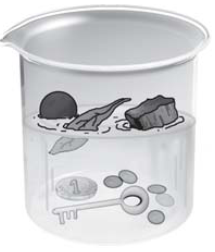
Some objects float in water while others sink in it
Activity–4
AIM : To find out substance which sink/float in water.
Material required : (i) a small stone (ii) a small piece of wood (iii)a coin (iv)a leaf (v)a brass screw
(vi) a small piece of ice (vii)a glass bowl filled with water.
Method : Take a glass bowl filled with water. In the water, drop the above mentioned substances one by one and observe what happens. We will notice that the stone, the key, the coin and the brass screw sink in water. Thus, they can be grouped as substances heavier than water.
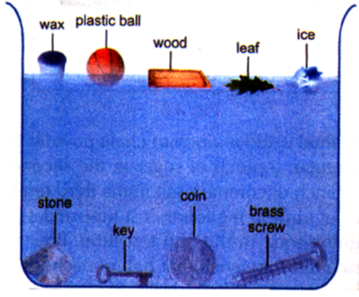
Fig. Material which sink or float in water
We will notice that the wax, the plastic ball, the wood, the leaf and ice float on the surface of water. Thus, they can be grouped as substances lighter than water. We can repeat the activity by dropping the above substances in kerosene oil or any other liquid and find out which float or sink in it.
(v) Transparency :
Those substances or materials, through which things can be seen, are called transparent. Light passes completely through these materials. Glass, water, air and some plastics are examples of transparent materials.
On the other hand, there are some materials through which we are not able to see i.e. light does not pass through them. These materials are called opaque. Wood, cardboard and metals, are example of opaque materials.
The materials through which light passes partially and objects can be seen but not clearly, are known as translucent. We can therefore group materials as opaque, transparent and translucent.
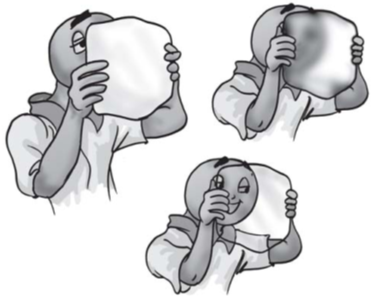
Looking through opaque, transparent or translucent material
Our palm is also translucent. When we put palm on torch then partially light passes through the hand. It prooves that our palm is also translucent.
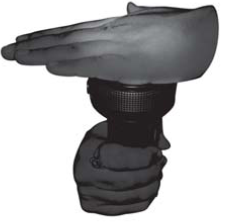
Does torch light pass through your palm?
Need to group Material
- Books Name
- CBSE Class 6 Science Book
- Publication
- Param Publication
- Course
- CBSE Class 6
- Subject
- Science
Need to group materials
In everyday life, we often group materials for our convenience. At home we usually store things in such a manner that similar objects are placed together. Such an arrangement helps us to locate them easily. Similarly, a grocer usually keeps all type of biscuits at one corner of his shop all soaps at another while grains and pulses are stored at some other place.
There is another reason why we find such grouping useful. Dividing materials in groups makes it convenient to study their properties and also observe any patterns in these properties.
KEY WORDS
1. Hard : Materials which cannot be pressed easily are called hard e.g., stone.
2. Insoluble : Materials which do not dissolve in water are called insoluble.
3. Lustre : Some materials have a special shine on them which is called lustre.
4. Material : The matter of which an object is made, is called material. For example, glass, steel,
wood, etc.
5. Metals : Materials which have certain properties like lustre, malleability, ductility and are sonorous, good conductors of heat and electricity, are called metals.
6. Opaque : Materials which do not allow light to pass through them are called opaque.
7. Rough : Some materials have uneven surface and feel rough on touching.
8. Soluble :Materials which dssolve in water are called soluble.
9. Translucent : Materials which partially allow light to pass through them are called translucent.
10. Transparent : Materials which allow light to pass through them are called transparent.

 Learnfromhome
Learnfromhome
 PathSet Publications
PathSet Publications
